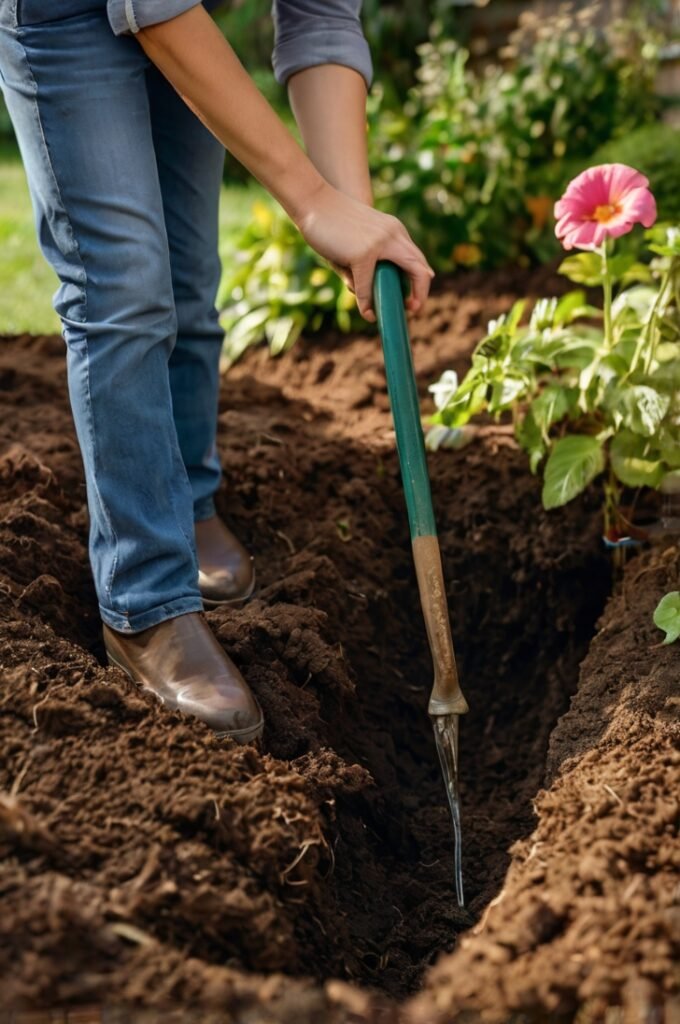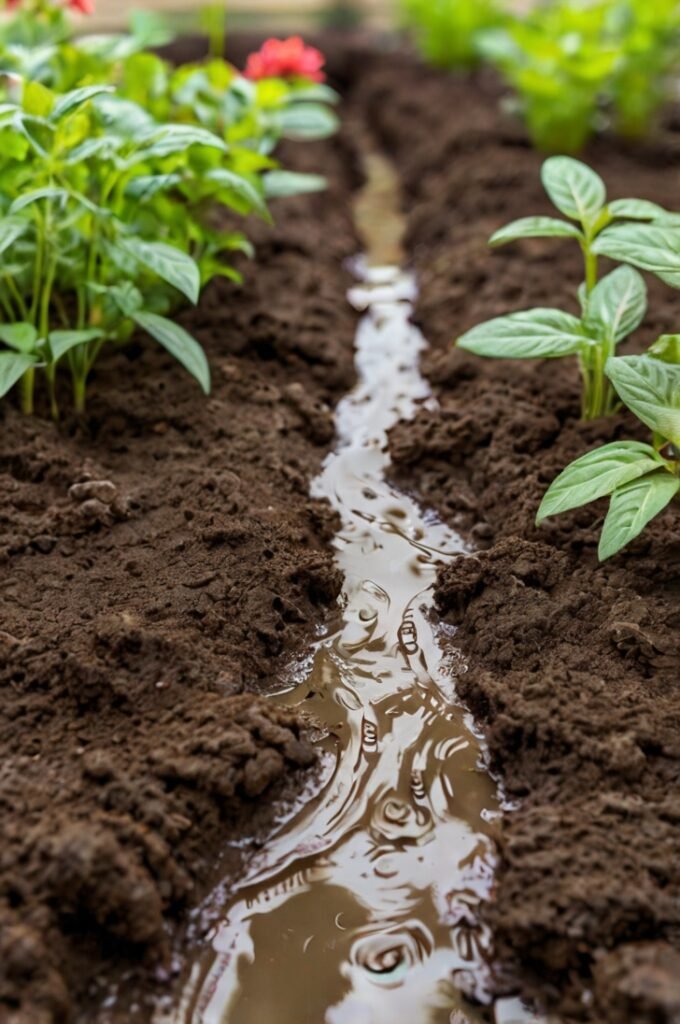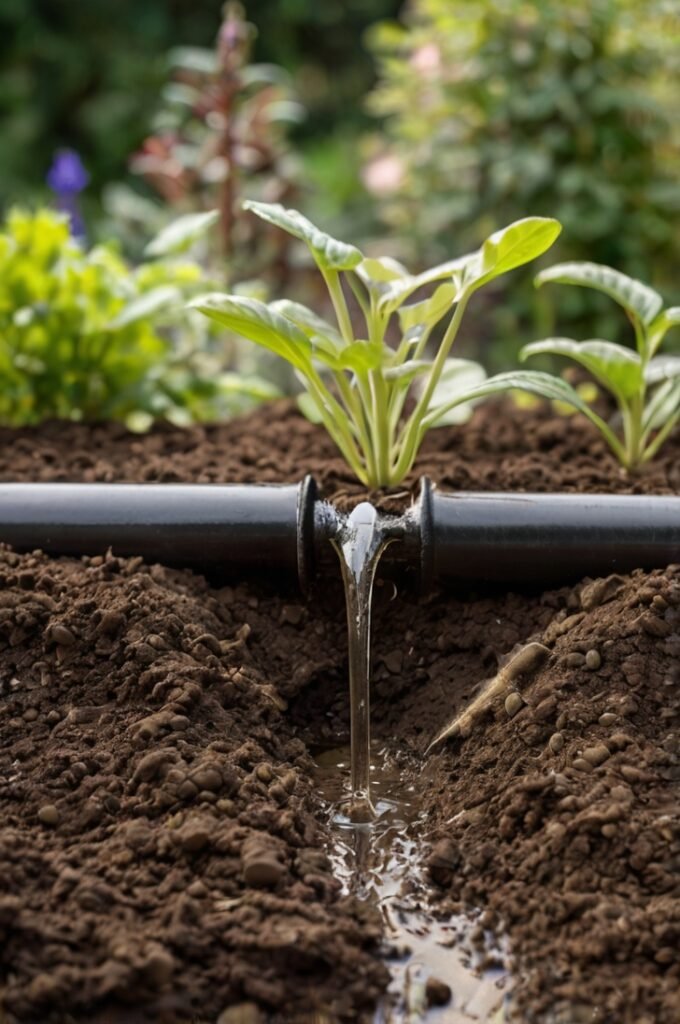
If you’re a gardener or homeowner, you’ve probably faced the frustration of poor soil drainage.
This issue can lead to waterlogged plants, unsightly puddles, and long-term damage to your garden.
Understanding and improving soil drainage is essential for maintaining a healthy, thriving garden.
In this post, we’ll explore what happens when your soil isn’t draining properly, identify the signs and causes of poor soil drainage, and provide practical solutions to improve it.
What Happens if Your Soil is Not Draining Properly
When soil doesn’t drain well, excess water accumulates, leading to several significant problems.
Here’s a closer look at these issues:
Root rot
Plants need oxygen to survive, and their roots obtain this oxygen from the air spaces within the soil.
When the soil is waterlogged, these air spaces fill with water, depriving roots of the oxygen they need.
Over time, this lack of oxygen causes roots to suffocate and die, leading to a condition known as root rot.
Root rot is particularly devastating because it can quickly spread through the plant, ultimately killing it.
Symptoms include wilting, yellowing leaves, and stunted growth, despite the soil being moist.
- Read also: Soil Mastery: A Guide To The Types of Soil for Gardening
- Read also: A Comprehensive Guide on How to Use Soil Conditioner
Nutrient deficiency
Proper soil drainage is crucial for maintaining balanced nutrient levels.
Poor drainage can lead to nutrient leaching, where essential minerals and nutrients are washed away from the root zone before plants can absorb them.
This process leaves plants weak and undernourished.
Common signs of nutrient deficiency include yellowing leaves (chlorosis), poor growth, and reduced flowering or fruiting.
Even if you are regularly fertilizing your garden, poor drainage can render these efforts ineffective.
Plant diseases
Wet, poorly drained soil creates the perfect environment for fungal and bacterial diseases.
Pathogens such as Pythium, Phytophthora, and Fusarium thrive in waterlogged conditions and can quickly infect plants, causing a variety of issues.
These diseases can lead to symptoms like wilting, leaf spots, blights, and stem cankers.
Once a disease takes hold, it can be challenging to control, often requiring chemical treatments and, in severe cases, the removal of affected plants to prevent the spread to healthy ones.
Soil erosion
Excess water can lead to soil erosion, which is the removal of the topsoil layer due to water flow.
This erosion can significantly damage the structure and fertility of your garden.
Topsoil is rich in organic matter and nutrients, which are essential for plant growth.
When this layer is eroded, the soil becomes less fertile and more compacted, making it difficult for plants to establish roots.
Soil erosion can also lead to the formation of gullies and rills, which further disrupt the garden landscape and make maintenance more challenging.
Puddling and waterlogging
Persistent puddles or waterlogged areas in your garden are clear indicators of poor drainage.
These standing water areas can create unsightly messes and make garden maintenance difficult.
Additionally, they can attract mosquitoes and other pests, creating an unhealthy environment for both plants and people.
Waterlogged soil also tends to compact more easily, further exacerbating drainage issues over time.

What Are the Signs of Poor Soil Drainage
Identifying poor soil drainage early can save your garden from significant damage.
Here are some common signs to help you recognize if your soil isn’t draining properly:
- Puddles that linger: After a rain or watering, puddles that persist for more than a day or two are a strong indication that your soil isn’t draining well.
- Water runs off quickly: If water tends to sheet off the surface of the soil rather than soaking in, it’s a sign that the drainage is poor. This is especially common with clay soil.
- Mushy or compacted soil: Soil that feels squishy or compacted when you try to dig in it likely has poor drainage. Healthy soil should be crumbly and loose.
- Discolored soil: Poorly drained soil may appear grayish or bluish in color, due to iron that isn’t getting enough oxygen. Rusty mottling can also be a sign.
- Presence of water-loving plants: If you see a lot of reeds, rushes, sedges, or skunk cabbage growing in your yard, it could be a sign that the soil is wet most of the time.
- Stunted or unhealthy plants: If your plants are generally unhealthy, failing to thrive, or have yellowing leaves, poor drainage could be the culprit.
- Mosy surfaces: Moss loves moisture and thrives in damp, shady areas. If you see a lot of moss growing on your soil or patio, it could be a sign of drainage problems.
- Cracked soil during dry periods: While this might seem counterintuitive, poorly drained soil can also be prone to cracking during dry periods. This is because the soil shrinks and expands unevenly as it goes through cycles of wet and dry.
What Causes Poor Soil Drainage
Several factors can lead to poor soil drainage, affecting how well water soaks in and moves through the ground.
Several factors contribute to poor soil drainage:
- Soil texture: Clay soils naturally have tiny particles that pack together tightly, leaving few spaces for water to infiltrate. Sandy soils, on the other hand, can drain too quickly, allowing water to rush through without properly nourishing plants. Ideally, you want a balance between different sized particles for optimal drainage.
- Soil compaction: Foot traffic, heavy machinery, or even frequent tilling can compress the soil, reducing the spaces for air and water to move through. Compacted soil becomes dense and struggles to drain properly.
- Impervious subsoil: Sometimes, the problem lies beneath the surface. An underlying layer of hardpan or another impermeable material can act as a barrier, preventing water from draining downward.
- Topography: Low-lying areas or depressions in your yard naturally collect water and may have poor drainage.
- Chemical makeup: High sodium levels in soil can disperse clay particles, clogging pores and hindering drainage.

How to Improve Soil Drainage
Improving soil drainage is essential for the health of plants, as poor drainage can lead to waterlogged roots and a variety of plant diseases.
Here are several methods to enhance soil drainage:
Add organic matter
This is a great all-around way to improve soil quality and drainage.
Compost, aged manure, and leaf mold are all excellent choices.
These organic materials decompose over time, creating spaces in the soil that allow water to drain more effectively.
Aim to mix in several inches of organic matter each year.
Applying mulch helps to improve soil structure over time as it decomposes, increasing organic matter content.
Encourage worms
Worms, particularly earthworms, play a significant role in enhancing soil drainage and overall soil health.
By encouraging these beneficial creatures in your garden, you can naturally improve soil structure and drainage.
Avoiding excessive tilling that can disrupt worm tunnels and can harm the worm population.
Opt for no-till gardening methods whenever possible, or use minimal tillage techniques.
Prevent compaction
Mixing coarse sand with clay soils can help break up the soil and improve drainage.
Avoid fine sand, as it can worsen compaction.
Perlite or vermiculite, these lightweight materials help aerate the soil and improve drainage.
For clay soils, gypsum can help break up compacted soil and improve drainage.

Raised beds
If you’re dealing with poor drainage in a specific planting area, consider creating raised beds.
These are essentially boxes filled with well-draining soil that sit on top of the existing ground.
This allows water to drain away from the roots of your plants.
Using aeration
For lawns, using a core aerator to remove plugs of soil can improve water infiltration.
For garden beds, double digging (digging and loosening the soil to a depth of about two feet) can significantly enhance drainage.
Install drainage systems
- French drains: Install a French drain (a trench filled with gravel containing a perforated pipe) to redirect water away from poorly draining areas.
- Dry wells: These are underground structures that collect and disperse excess water, allowing it to percolate into the surrounding soil slowly.
- Swales: Shallow ditches can be created to direct water flow away from problem areas.
Planting cover crops
Planting cover crops (Green manure) in between planting seasons can help improve soil structure and drainage.
Different cover crops have different root structures.
Grasses, for example, have dense fibrous roots that help create channels for water to infiltrate the soil.
Deep-rooted legumes and brassicas like radish can also help break up compacted soil, allowing for better drainage.
As cover crops decompose, they add organic matter to the soil.
This organic matter improves soil aeration and water infiltration, ultimately leading to better drainage.
Cover crops also support a healthy population of earthworms and other beneficial soil biota.
These creatures create tunnels and pore spaces in the soil, further enhancing drainage.

- Read also: Guide 101: How to Lower pH in Soil for a Thriving Garden
- Read also: Topsoil vs. Garden Soil: Understanding the Difference
Conclusion
Improving soil drainage is crucial for a healthy, vibrant garden.
By recognizing the signs of poor drainage and understanding its causes, you can take effective steps to enhance your soil.
With a bit of effort and knowledge, you can transform your waterlogged garden into a thriving oasis.
FAQs
Plants like sedges, swamp milkweed, and certain varieties of iris can tolerate poorly drained soil and thrive in wet conditions.
Dig a hole about 12 inches deep and fill it with water. If the water takes more than 24 hours to drain, your soil has poor drainage.
Improving soil drainage is an ongoing process. Regularly amending the soil with organic matter, aerating the soil, and maintaining drainage systems are necessary to ensure long-term effectiveness and a healthy garden environment.



